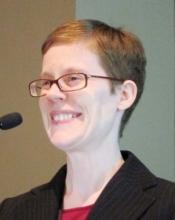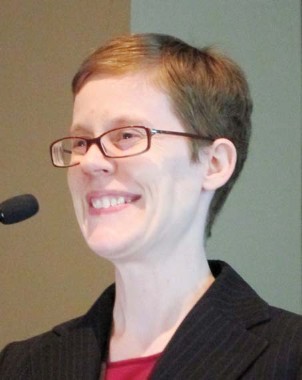User login
WASHINGTON – Only about 40% of girls old enough to receive the HPV vaccine got the first dose during a year in which they were seen at least once in an urban community clinic, a study has shown.
The large cohort study also found that 53% of girls underwent a sexual health screening before initiating the HPV series, suggesting that many are already sexually active but unprotected, Dr. Annnika Hofstetter said at the annual meeting of the Pediatric Academic Societies.
The finding points out the importance of early education about HPV and sexual safety for both girls and parents, said Dr. Hofstetter of New York–Presbyterian Hospital.
"Even in settings with high HPV vaccine initiation rates, the series is often delayed," she said. "Promotion of early HPV vaccination consistent with [federal] guidelines is crucial."
Dr. Hofstetter examined the timing of the initial HPV vaccination in relation to age and sexual activity in 23,900 females aged 11-26 years. All had been seen at least once in any of 16 large urban health care clinics (family planning, ob.gyn., school-based health, pediatric, and family medicine). She divided the cohort into two subgroups: an age analysis of 10,489 who were 11-26 years old, and a sexual health screening analysis of 15,049 who were aged 11-19 years. The two subgroups add up to more that the total because there was overlap between them. The sexual health screening cohort included only girls who were getting the Pap smear and chlamydia test because they were considered to be sexually active.
Most of the cohort (78%) was Hispanic; 18% were black, and the rest were non-Hispanic whites. Most (72%) were also publicly insured; 23% had private insurance, and 5% had no health care coverage at all. Because all were at least 11 years old, all were eligible to receive the vaccine. If the vaccine wasn’t given during a visit, it was considered a "missed opportunity."
The first analysis included girls aged 11-26 years. It examined the age of first HPV vaccination in each year from 2007 to 2011. The percentage of girls who had at least the initial vaccination rose significantly over the study period, from about 35% in 2007 to 69% in 2011.
Vaccination rates were highest in the girls aged 11-12 and 13-17 years, but only about 40% of each group were vaccinated in each of the study years – leaving the other 60% unvaccinated.
When she compared the number of clinic visits with each girl’s immunization status, Dr. Hofstetter found a median of two to three missed vaccination opportunities for every year. About half of those who did get vaccinated had at least one missed opportunity before they got the first dose.
The second analysis examined sexual health screening – chlamydia testing and Pap smear – in relationship to vaccination timing. The tests were considered a proxy for sexual activity. Girls in this group were aged 11-19 years and had not yet been vaccinated.
More than half of this group (54%) had either a Pap smear (17%) or chlamydia test (37%). Of the chlamydia screens, 30% were negative and 7% were positive. Of the Pap smears, 11% were normal and 7% were abnormal.
During the discussion, a physician from Sweden said that some preschoolers in the country have been offered the series. "Giving it that early removes this entire question of prevaccination sexual activity," he said.
The study was partially funded by Merck. Dr. Hofstetter said she had no relevant financial disclosures.
WASHINGTON – Only about 40% of girls old enough to receive the HPV vaccine got the first dose during a year in which they were seen at least once in an urban community clinic, a study has shown.
The large cohort study also found that 53% of girls underwent a sexual health screening before initiating the HPV series, suggesting that many are already sexually active but unprotected, Dr. Annnika Hofstetter said at the annual meeting of the Pediatric Academic Societies.
The finding points out the importance of early education about HPV and sexual safety for both girls and parents, said Dr. Hofstetter of New York–Presbyterian Hospital.
"Even in settings with high HPV vaccine initiation rates, the series is often delayed," she said. "Promotion of early HPV vaccination consistent with [federal] guidelines is crucial."
Dr. Hofstetter examined the timing of the initial HPV vaccination in relation to age and sexual activity in 23,900 females aged 11-26 years. All had been seen at least once in any of 16 large urban health care clinics (family planning, ob.gyn., school-based health, pediatric, and family medicine). She divided the cohort into two subgroups: an age analysis of 10,489 who were 11-26 years old, and a sexual health screening analysis of 15,049 who were aged 11-19 years. The two subgroups add up to more that the total because there was overlap between them. The sexual health screening cohort included only girls who were getting the Pap smear and chlamydia test because they were considered to be sexually active.
Most of the cohort (78%) was Hispanic; 18% were black, and the rest were non-Hispanic whites. Most (72%) were also publicly insured; 23% had private insurance, and 5% had no health care coverage at all. Because all were at least 11 years old, all were eligible to receive the vaccine. If the vaccine wasn’t given during a visit, it was considered a "missed opportunity."
The first analysis included girls aged 11-26 years. It examined the age of first HPV vaccination in each year from 2007 to 2011. The percentage of girls who had at least the initial vaccination rose significantly over the study period, from about 35% in 2007 to 69% in 2011.
Vaccination rates were highest in the girls aged 11-12 and 13-17 years, but only about 40% of each group were vaccinated in each of the study years – leaving the other 60% unvaccinated.
When she compared the number of clinic visits with each girl’s immunization status, Dr. Hofstetter found a median of two to three missed vaccination opportunities for every year. About half of those who did get vaccinated had at least one missed opportunity before they got the first dose.
The second analysis examined sexual health screening – chlamydia testing and Pap smear – in relationship to vaccination timing. The tests were considered a proxy for sexual activity. Girls in this group were aged 11-19 years and had not yet been vaccinated.
More than half of this group (54%) had either a Pap smear (17%) or chlamydia test (37%). Of the chlamydia screens, 30% were negative and 7% were positive. Of the Pap smears, 11% were normal and 7% were abnormal.
During the discussion, a physician from Sweden said that some preschoolers in the country have been offered the series. "Giving it that early removes this entire question of prevaccination sexual activity," he said.
The study was partially funded by Merck. Dr. Hofstetter said she had no relevant financial disclosures.
WASHINGTON – Only about 40% of girls old enough to receive the HPV vaccine got the first dose during a year in which they were seen at least once in an urban community clinic, a study has shown.
The large cohort study also found that 53% of girls underwent a sexual health screening before initiating the HPV series, suggesting that many are already sexually active but unprotected, Dr. Annnika Hofstetter said at the annual meeting of the Pediatric Academic Societies.
The finding points out the importance of early education about HPV and sexual safety for both girls and parents, said Dr. Hofstetter of New York–Presbyterian Hospital.
"Even in settings with high HPV vaccine initiation rates, the series is often delayed," she said. "Promotion of early HPV vaccination consistent with [federal] guidelines is crucial."
Dr. Hofstetter examined the timing of the initial HPV vaccination in relation to age and sexual activity in 23,900 females aged 11-26 years. All had been seen at least once in any of 16 large urban health care clinics (family planning, ob.gyn., school-based health, pediatric, and family medicine). She divided the cohort into two subgroups: an age analysis of 10,489 who were 11-26 years old, and a sexual health screening analysis of 15,049 who were aged 11-19 years. The two subgroups add up to more that the total because there was overlap between them. The sexual health screening cohort included only girls who were getting the Pap smear and chlamydia test because they were considered to be sexually active.
Most of the cohort (78%) was Hispanic; 18% were black, and the rest were non-Hispanic whites. Most (72%) were also publicly insured; 23% had private insurance, and 5% had no health care coverage at all. Because all were at least 11 years old, all were eligible to receive the vaccine. If the vaccine wasn’t given during a visit, it was considered a "missed opportunity."
The first analysis included girls aged 11-26 years. It examined the age of first HPV vaccination in each year from 2007 to 2011. The percentage of girls who had at least the initial vaccination rose significantly over the study period, from about 35% in 2007 to 69% in 2011.
Vaccination rates were highest in the girls aged 11-12 and 13-17 years, but only about 40% of each group were vaccinated in each of the study years – leaving the other 60% unvaccinated.
When she compared the number of clinic visits with each girl’s immunization status, Dr. Hofstetter found a median of two to three missed vaccination opportunities for every year. About half of those who did get vaccinated had at least one missed opportunity before they got the first dose.
The second analysis examined sexual health screening – chlamydia testing and Pap smear – in relationship to vaccination timing. The tests were considered a proxy for sexual activity. Girls in this group were aged 11-19 years and had not yet been vaccinated.
More than half of this group (54%) had either a Pap smear (17%) or chlamydia test (37%). Of the chlamydia screens, 30% were negative and 7% were positive. Of the Pap smears, 11% were normal and 7% were abnormal.
During the discussion, a physician from Sweden said that some preschoolers in the country have been offered the series. "Giving it that early removes this entire question of prevaccination sexual activity," he said.
The study was partially funded by Merck. Dr. Hofstetter said she had no relevant financial disclosures.
AT THE PAS ANNUAL MEETING
Major finding: A comparison of the number of clinic visits with each girl’s HPV immunization status found a median of two to three missed vaccination opportunities for every year.
Data source: Two cohorts totaling 23,900 girls and women aged 11-26 years.
Disclosures: The study was partially funded by Merck. Dr. Hofstetter said she had no relevant financial disclosures.

